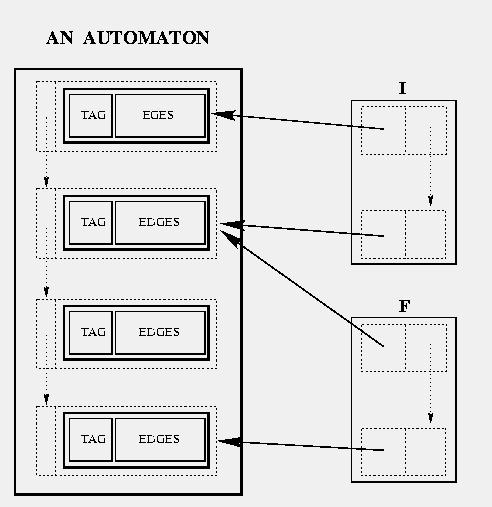| type |
identity |
description |
| Sigma |
X::Sigma |
The user defined type Sigma, set of the transitions possible labels |
| Alphabet |
X::Alphabet |
also X::Sigma::Alphabet, the user defined type used for transitions labels (ie:type of the Sigma elements) |
| State |
X::State |
A type used to reference a state (a handler). this is a built in type. |
| StateData |
X::StateData |
type of the state (its contents) |
| Const iterator |
X::const_iterator |
forward
iterator on the automaton states, read only. |
| Edges |
X::Edges |
a key-associative container holding the outgoing transitions of a state. |
| Tag |
X::Tag |
type of the objects holding data associated with a state (such things as being final, before ASTL 1.1, now only used for user defined tags) |
| name |
expression |
precondition |
semantics |
postconditions |
| Null state |
a.null_state |
... |
State equivalent of NULL |
... |
| Beginning of states set |
a.begin() |
... |
returns a const_iterator pointing to the first state in the automaton |
past the end if no states |
| End of states set |
a.end() |
... |
returns a const_iterator pointing one past the last state in the automaton |
past the end |
| creating a new state |
a.new_state() |
the automaton must be editable |
allocates a new state |
... |
| deleting a state |
a.del_state(from) |
the automaton must be editable |
desallocates the state referenced by from |
... |
| copying a state into an other |
a.copy_state(from, to) |
the automaton must be editable |
copies the content of from in to |
... |
| duplicating a state |
a.duplicate_state(from) |
the automaton must be editable |
copies from into a newly allocated state |
... |
| number of states |
a.state_count() |
... |
returns the current number of states of this automaton |
... |
| setting a transition between two states |
a.set_trans(from,l,two) |
the automaton must be editable |
adds a transition by l from from to to |
... |
| deleting a transition |
a.del_trans(...) |
the automaton must be editable |
removes a transition |
... |
| modyfing the aim of a transition |
a.change_trans(...) |
... |
changes the aim of a transition |
... |
 |
a.delta1(from, l) |
... |
returns the states reachable from from by l |
returns null_state if the transition does not exist |
 |
a.delta2(from) |
... |
returns the set of all outgoing transitions of state from |
... |
| number of transitions |
a.trans_count() |
... |
returns the current number of transitions of this automaton |
... |
| get initials states |
a.initial() |
... |
returns I |
null_state if none |
| set an initial state |
a.initial(from) |
... |
sets from as an initial state |
... |
| get finality |
a.final(from) |
s is a const |
returns the finality of from |
... |
| get a finality reference |
a.final(from) |
... |
returns a reference on the finality of from, thus allowing modification |
... |
| tag |
a.tag(from) |
... |
return the Tag associated with state from |
... |



 be the 7-uple of sets representing the automaton, with
be the 7-uple of sets representing the automaton, with

 Q
Q Q
Q
 Q x
Q x x Q
x Q
 Q x T
Q x T astwo distinct transition functions
astwo distinct transition functions  and
and  according to the most frequent operations needed on an automaton.
according to the most frequent operations needed on an automaton.

 xQ and two subsets of Q.
xQ and two subsets of Q.



